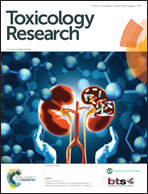Modeling the toxicity of chemical pesticides in multiple test species using local and global QSTR approaches†
Abstract
The safety assessment processes require the toxicity data of chemicals in multiple test species and thus, emphasize the need for computational methods capable of toxicity prediction in multiple test species. Pesticides are designed toxic substances and find extensive applications worldwide. In this study, we have established local and global QSTR (quantitative structure–toxicity relationship) and ISC QSAAR (interspecies correlation quantitative structure activity–activity relationship) models for predicting the toxicities of pesticides in multiple aquatic test species using the toxicity data in crustacean (Daphnia magna, Americamysis bahia, Gammarus fasciatus, and Penaeus duorarum) and fish (Oncorhynchus mykiss and Lepomis macrochirus) species in accordance with the OECD guidelines. The ensemble learning based QSTR models (decision tree forest, DTF and decision tree boost, DTB) were constructed and validated using several statistical coefficients derived on the test data. In all the QSTR and QSAAR models, Log P was an important predictor. The constructed local, global and interspecies QSAAR models yielded high correlations (R2) of >0.941; >0.943 and >0.826, respectively between the measured and model predicted endpoint toxicity values in the test data. The performances of the local and global QSTR models were comparable. Furthermore, the chemical applicability domains of these QSTR/QSAAR models were determined using the leverage and standardization approaches. The results suggest for the appropriateness of the developed QSTR/QSAAR models to reliably predict the aquatic toxicity of structurally diverse pesticides in multiple test species and can be used for the screening and prioritization of new pesticides.


 Please wait while we load your content...
Please wait while we load your content...